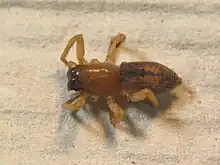| Clubiona subsultans | |
|---|---|
 | |
| Scientific classification | |
| Domain: | Eukaryota |
| Kingdom: | Animalia |
| Phylum: | Arthropoda |
| Subphylum: | Chelicerata |
| Class: | Arachnida |
| Order: | Araneae |
| Infraorder: | Araneomorphae |
| Family: | Clubionidae |
| Genus: | Clubiona |
| Species: | C. subsultans |
| Binomial name | |
| Clubiona subsultans | |
| Synonyms[1] | |
| |
Clubiona subsultans, the Caledonian sac spider,[2] is a spider from the family Clubionidae with a Palearctic distribution.[1]
Description
The body length of female Clubiona subsultans varies from 5–7 mm, that of males from 5–9 mm.[3] The tibial apophysis is pointed and has 2 barbs. The prosoma is golden-brown, the chelicerae are brownish and the legs yellow. The abdomen is reddish brown with yellow spots and a black median band with white arc-lines.[3]
Habitat and ecology
Clubiona subsultans is normally found under stones and bark and in moss and litter, mostly in coniferous forests.[3] In Britain it is called Caledonian sac-spider because the native Scots pine forest is the normal habitat. Clubiona subsultans is associated with Caledonian pine woods, where it has been found under bark, on branches, in pine litter, among young pines, and on juniper growing as an under-storey within a pine wood. Recently it was found to have been the commonest spider caught in artificial nestbox traps which were put out in Abernethy Forest to survey for the bee Osmia uncinata. Adult male and female spiders have been found in June, the males also in September.[4]
Distribution
Clubiona subsultans has a Palearctic distribution.[1] In Europe it is found in northern and central Europe.[4] In Great Britain this species is confined to relict patches of Caledonian Forest in north-central Scotland,[4] giving rise to the species common name of Caledonian sac spider.
Conservation
In Scotland Clubiona subsultans is threatened by the loss of Caledonian pine forest, especially through the planting of Scots pine and non-native conifers in large blocks, which is sometimes preceded by the clear-felling of the native pine. To conserve this spider the management of the forest should be aimed at conserving the pine and other native trees. The natural regeneration of Scots pine should be allowed to proceed to give the typical open forest structure of the Caledonian forest. If regeneration is too dense then early thinning of the saplings may be needed to create glades. The main site at Abernethy is now a reserve of the Royal Society for the Protection of Birds and its primary aim is to develop a self-sustaining native pine forest over the whole potential woodland area.[4]
References
- 1 2 3 4 "Clubiona subsultans Thorell, 1875". World Spider Catalogue. Natural History Museum Bern. Retrieved 21 September 2016.
- ↑ "Information and Advisory Note Number 139: NATURAL HERITAGE TRENDS Forest and woodland: native woodland". Scottish Natural Heritage. Archived from the original on 14 July 2016. Retrieved 21 September 2016.
- 1 2 3 "Clubiona subsultans Thorell, 1875". Nentwig W, Blick T, Gloor D, Hänggi A, Kropf C: Spiders of Europe. Retrieved 21 September 2016.
- 1 2 3 4 "Summary for Clubonia subsultans". British Arachnological Society. Retrieved 21 September 2016.